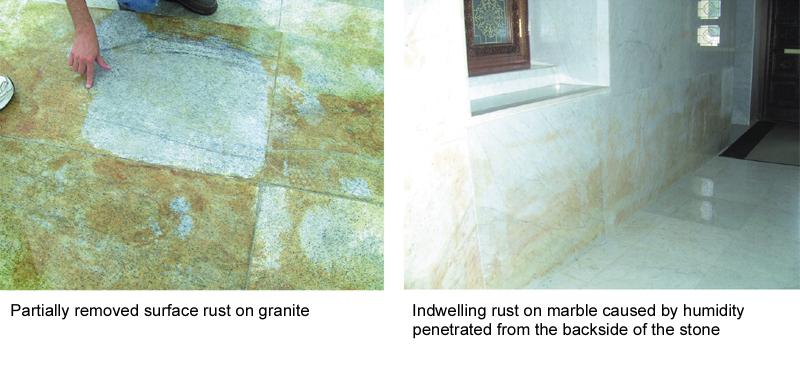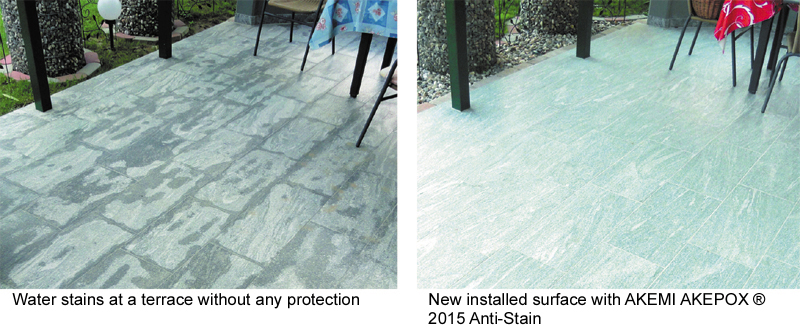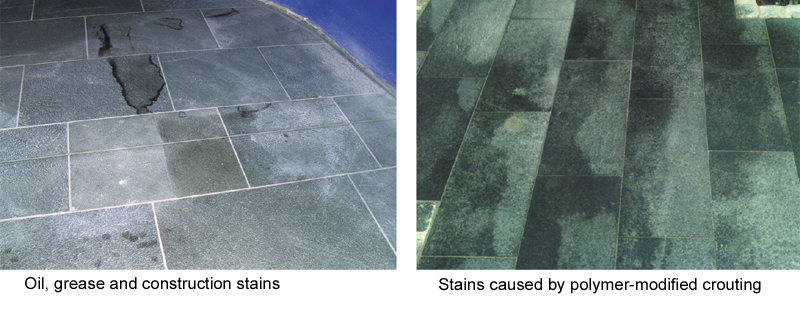Dipl.-Ing. Adviser Johannes Albert, Senior technical adviser Akemi, info@akemi.de
Natural stones offer countless opportunities for sustainable design in private or public places outdoors (e.g. terraces, gateways, parks or monuments). Although Natural Stones, particularly hard stones like granites or basalts, generally show a good weather resistance, there are important aspects to follow for outdoor installations. The following article describes which external influences can affect natural stones and what shall be done to achieve a long term protection.
In general natural stones have three main enemies if used outdoors: humidity (penetration of water), climate (UV radiation, frost-thaw changes) and staining substances (oil, food or grouting).
1.- PROBLEMS CAUSED BY HUMIDITY
Constant humidity (by penetrating from the backside soil into the stone) is a big challenge, to be mastered.
1.1. Problems which can be solved easily after installation
The growth of algae and moss is still one of the more harmless effects, which are caused by constant humidity. This kind of fouling can easily be removed with slightly alkaline cleaners based on active chlorine compounds.
The removal of rust might cause more difficulties. On acid resistant stones, surface rust as well as rust stains caused by indwelling rust can usually be removed with rust removing agent inorganic acids. High quality products don’t only remove visual rust, but also envelope occlusions in natural stones which cause the rust; this inhibits the formation of new rust.
1.2. Problems which must be solved before installation
On non-acid resistant stones, like limestone or marble, rust can be a non-repairable problem. Although specialized non-acidic products can remove surface rust on marble or limestone, the indwelling rust, caused by constant induction of humidity (mostly from the backside of the stone), cannot be removed.

Irreparable damage can also be caused by permanent humidity in combination with immigrated minerals or salts, out of the subsoil or foundation. These stains may first appear as dark spots, which come and go for some days, but after some month they change the mineral structure of the stones and stay forever. If salts are involved, the lime crystallizes not only on the surface, but also in the capillary system of the stones. This causes chipping and destroys the surface. This effect can be observed in all climate zones. The only way to prevent these irreparable problems from the beginning is to protect the natural stone in a proper way, before installing.

Regarding the technical solution we have to differ between stone tiles which are laid loosely on grit or sand which are permanently fixed with mortar/cement or tile adhesives.
For permanently installed tiles, the only sustainable one way to protect the stone from stains caused by humidity (rust, efflorescence, water stains) is the backside sealing with special two component coating materials (e.g. AKEMI AKEPOX® 2015 Anti-Stain). Such systems shall be applied on the backside and the four sides of the natural stone tile. The final sanding with quartz sand serves as a adhesion promoter between the coating system on the stone and the mortar. The treatment can be done in the factory or on site. In addition it is recommendable to protect the frontside of the stone with a water, oil and dirt repellent impregnation.
For the loosely installed tiles (on grit or sand), it´s also recommended to apply, a Backside coating system, however in this case the final sanding with quartz sand is not necessary because the adhesion promoter to the grit or sand is not needed.


2.- PROBLEMS CAUSED BY THE CLIMATE
UV-radiation, weathering and acid rain can cause damages on the stone surface especially on soft materials stones like marble or limestone. Polished marble and limestone will lose their gloss and become matt; they appear to be bleached out.
 There is no treatment to avoid a limestone or marble from getting matt or losing its gloss, but there is a possibility to refresh the colour of the stone easily with single component chemical agents, instead of a time consuming re-polishing process of the whole surface. Colour intensifying agents (e.g. AKEMI Darkener Super) enhance the natural colour and structure of all stones (limestone, marble, granite etc.). Such specialized impregnators are penetrating into the surface of the stone; however they not do form a layer on top of it. The stone keeps its ability to breathe.
There is no treatment to avoid a limestone or marble from getting matt or losing its gloss, but there is a possibility to refresh the colour of the stone easily with single component chemical agents, instead of a time consuming re-polishing process of the whole surface. Colour intensifying agents (e.g. AKEMI Darkener Super) enhance the natural colour and structure of all stones (limestone, marble, granite etc.). Such specialized impregnators are penetrating into the surface of the stone; however they not do form a layer on top of it. The stone keeps its ability to breathe.In climate zones, exposed to frost and thaw, the stone surface is permanently stressed. Usually limestone is more sensitive to frost than hard stones (e.g. granite). To protect the stone against chipping and weathering, an impregnation is highly recommended. The impregnation will keep the vapour permeability of the stone. This does not apply to layer forming sealers (based on acrylic or other lacquers). Such sealers will close the surface and will not allow the humidity from the backside to evaporate (if not treated according to 1.2). This “trapped” humidity will change the transparent colour of the frontside sealer layer into a blind, milky-white surface appearance. In case of frost, the liquid water in the stone will freeze and break the material on the surface (especially on limestone). Therefore, layer forming sealers are not suited for surface treatments in outdoor areas.
3.- PROBLEMS CAUSED BY STAINING SUBSTANCES
Natural stone surfaces in outside areas are often affected by all different kind of stains. For example in foodcourts or barbeque places, spoiled food, oil and grease can cause ugly contamination. Also pollution like smog can impair the beauty of the natural stone.

Another problem occurs already during the process of flooring: If joint grouting is not removed in time, it can leave concrete films on the surface of the stone. Often it is very hard to remove this excess material afterwards, especially if polymer-modified grouting materials were used. Of course there are special cleaners (e.g. AKEMI Oil and Grease Remover Paste, AKEMI Concrete Film Remover or AKEMI Epoxy Remover) for this kind of stains, but the cleaning process and maintenance can be simplified if the stone has been protected in advance with the right impregnation.

Impregnators can also protect against all kind of organic substances like discolouration caused by leaves, coffee, spices and tannins with vegetable origin can be prevented to penetrate into the stone, with the right impregnation.

Generally we have to distinguish between four different kinds of impregnations:
a)Protection against water and dirt
b)Protection against oil or grease
c)Colour intensifying or non colour intensifying impregnators
d)Solvent based and water based
The choice of the correct impregnator depends on the requirement of each project. A façade which is only exposed to wind and rain requires generally an impregnation against water and dirt. If the stone surface is highly frequented and exposed to all kind of stains (e.g. foodcourts) impregnators with a repellent effect against oil, grease and organic substances are needed. Colour intensifying impregnators provide a beautiful and permanent wet effect, especially on rough surfaces (flamed, bush hammered) where the colour and structure are often faded. In order not to reduce the durability of the protection natural stones should be treating with professional daily cleaners free of acid, lye and phosphates (e.g. AKEMI Crystal Clean).
Conclusion:
A lot of different influences can affect natural stones in outside areas. However technical solutions are available. The following work procedure is recommended:
1.- Protect the stone from the backside against humidity with a coating system
2.- Remove with a basic cleaner all construction dirt
3.- Protect the surface against climate effects and staining substances with the right stain repellent or colour intensifying impregnation
4.- Use for natural stone certified cleaners for maintenance
